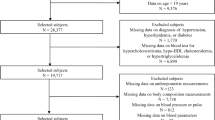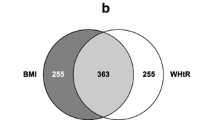Abstract
No single anthropometric parameter has yet been generally accepted as being superior to others in assessing the metabolic risk associated with abdominal obesity. To compare waist circumference (WC) with waist-to-hip ratio (WHR) and waist-to-height ratio (WHtR), regarding their association with serum lipids, we studied 166 women aged 20 to 48 yr; 53 were obese [body mass index (BMI) 30–39.9 Kg/m2], 50 were overweight (BMI 25–29.9 Kg/m2) and 63 normal weight (BMI 18.5–24.9 Kg/m2). Height, body weight, waist and hip circumferences, total serum cholesterol (Ch), low (LDL) and high density lipoprotein (HDL)-Ch and triglyceride (TG) concentrations were measured. The correlation coefficients between the concentration of serum lipid fractions and each anthropometric parameter did not differ significantly for any lipid variable when WC, WHR and WHtR were compared in the 166 women. The same applied for the obese and the overweight group, whereas in normal weight women there was significant association only between WC and LDL-Ch and between WHR and Ch/HDL-Ch ratio. Stepwise regression analysis showed that the proportion of variance in serum lipids did not change significantly when WHR or WHR+WHtR were added to WC into the regression model (18%, 18% and 18% for Ch; 13%, 18% and 18% for HDL-Ch; 18%, 18% and 12% for LDL-Ch; 35%, 35% and 37% for TG, respectively). These results indicate that WC is the main parameter associated with serum lipid levels and that the ratios studied do not provide additional substantial information in women who need weight management.
Similar content being viewed by others
References
Kissebah AH, Krakower GR. Regional adiposity and morbidity. Physiol Rev 1994, 74: 761–811.
Wajchenberg BL. Subcutaneous and visceral adipose tissue; their relation to the metabolic syndrome. Endocr Rev 2000, 21: 697–738.
James RW, Brulhart-Meynet MC, Lehmann T, Golay A. Lipoprotein distribution and composition in obesity: their association with central adiposity. Int J Obes 1997, 21: 1115–20.
Castelli WP. Epidemiology of coronary heart disease: The Framingham study. Am J Med 1984, 76: 4–12.
Lamarche B, Tchernof A, Mauriège P, et al. Fasting insulin and apolipoprotein B levels and low-density lipoprotein particle size as risk factors for ischemic heart disease. JAMA 1998, 279: 1955–61.
Kobayashi J, Tashiro J, Murano S, Morisaki N, Saito Y. Lipoprotein lipase mass and activity in post-heparin plasma from subjects with intra-abdominal visceral fat accumulation. Clin Endocrinol 1998; 48: 515–20.
Rainwater DL, Mitchell BD, Comuzzie AG, Haffner SM. Relationship of low-density lipoprotein particle size and measures of adiposity. Int J Obes 1999, 23: 180–9.
Lemieux I, Pascot A, Couillard C, et al. Hypertriglyceridemic waist. A marker of the atherogenic metabolic triad (hyperinsulinemia, hyperapolipoprotein B; small, dense LDL) in men? Circulation 2000, 102: 179–84.
Senti M, Bosch M, Aubo C, Elosua R, Masia R, Marrugat J. Relationship of abdominal obesity and dyslipemic status in women with a common mutation in the lipoprotein lipase gene. The REGICOR investigators. Atherosclerosis 2000, 150: 135–41.
Abate N, Garg A, Peshock RM, Stray Gundersen J, Grundy SM. Relationships of generalized and regional adiposity to insulin sensitivity in men. J Clin Invest 1995, 96: 88–98.
Goodpaster BH, Thaete FL, Simoneau J-A, Kelley DE. Subcutaneous abdominal fat and thigh muscle composition predict insulin sensitivity independently of visceral fat. Diabetes 1997, 46: 1579–85.
Seidell JC, Bouchard C. Visceral fat in relation to health: is it major culprit or simply an innocent bystander? Int J Obes 1997, 21: 626–31.
Pouliot MC, Després JP, Lemieux S, et al. Waist circumference and abdominal sagittal diameter: Best simple anthropometric indexes of abdominal visceral adipose tissue accumulation and related cardiovascular risk in men and women. Am J Cardiol 1994, 73: 460–8.
Lean ME, Han TS, Deurenberg P. Predicting body composition by densitometry from single anthropometric measurements. Am J Clin Nutr 1996, 63: 4–14.
Lemieux S, Proud’homme D, Bouchard C, Desprès JP. A single threshold value of waist girth identifies normal-weight and overweight subjects with excess visceral adipose tissue. Am J Clin Nutr 1996, 64: 685–93.
Ross R, Rissanen J, Hudson R. Sensitivity associated with the identification of visceral adipose tissue levels using waist circumference in men and women: effects of weight loss. Int J Obes 1996, 20: 533–8.
Barnes VA, Treiber FA, Davis H, Kelly TR, Strong WB. Central adiposity and hemodynamic functioning at rest and during stress in adolescents. Int J Obes 1998, 22: 1079–83.
Rissanen P, Hamalainen P, Vanninen E, Tenhunen-Eskelinen M, Uusitupa M. Relationship of metabolic variables to abdominal adiposity measured by different anthropometric measurements and dual-energy X-ray absorptiometry in obese middle-aged women. Int J Obes Relat Metab Disord 1997, 21: 367–71.
Taylor RW, Keil D, Gold EJ, Williams SM, Goulding A. Body mass index, waist girth and waist-to-hip ratio as indexes of total regional adiposity in women: evaluation using receiver operating characteristics curves. Am J Nutr 1998, 67: 44–9.
Megnien JL, Denarie N, Cocaul M, Simon A, Levenson J. Predictive value of waist-to- hip ratio on cardiovascular risk events. Int J Obes Relat Metab Disord 1999, 23: 90–7.
Molarius A, Seidell JC. Selection of anthropometric indicators for classification of abdominal fatness-a critical review. Int J Obes Relat Metab Disord 1998, 22: 719–27.
Sjöström CD, Lissner L, Sjöström L. Relationships between changes in body composition and changes in cardiovascular risk factors: The SOS intervention study. Obes Res 1997, 5: 519–30.
Ashwell M, Cole TJ, Dixon AK. Ratio of waist circumference to height is strong predictor of intraabdominal fat. BMJ 1996, 313: 559–60.
Ashwell M, Lejeune S, McPeterson K. Ratio of waist circumference to height may be better indicator of need for weight management. BMJ 1996, 312: 377–8.
Han TS, Lean MEJ, Seidell JC. Waist circumference remains useful predictor of coronary heart disease. BMJ 1996, 312: 1227–8.
Schoen RE, Thaete FL, Sankey SS, Weissfeld JL, Kuller LH. Sagittal diameter in comparison with single slice CT as a predictor of total visceral adipose tissue volume. Int J Obes Relat Metab Disord 1998, 22: 338–42.
Owens S, Litaker M, Allison J, Riggs S, Ferguson M, Gutin B. Prediction of visceral adipose tissue from simple anthropometric measurements in youths with obesity. Obes Res 1999, 7: 16–22.
Clinical guidelines on the identification, evaluation, and treatment of overweight and obesity in adults: Executive summary. Expert Panel on the Identification, Evalutation, and Treatment of Overweight in Adults. Am J Clin Nutr 1998, 68: 899–917.
Ashwell M, Chinn S, Stalley S, Garrow JS. Female fat distribution- a simple classification based on two circumference measurements. Int J Obes Relat Metab Disord 1982, 6: 143–52.
Björntorp P. Regional patterns of fat distribution. Ann Intern Med 1985, 103: 994–5.
Han TS, van Leer EM, Seidell JC, Lean ME. Waist circumference action levels in the identification of cardiovascular risk factors: prevalence study in a random sample. BMJ 1995, 311: 1401–5.
Sugiuchi H, Uji Y, Okabe H, et al. Direct measurement of high-density lipoprotein cholesterol in serum with polyethylene glycol-modified enzymes and sulfated alpha- cyclodextrin. Clin Chem 1995, 41: 717–23.
Friedewald WT, Levi RI, Fredrikson DS. Estimation of the concentration of low density lipoprotein cholesterol in plasma without use of the preparation ultracentrifuge. Clin Chem 1972, 18: 499–502.
Després JP, Lemieux I, Proud’homme D. Treatment of obesity: need to focus on high risk abdominally obese patients. BMJ 2001, 322: 716–20.
Kiernan M, Winkleby MA. Identifying patients for weightloss treatment: an empirical evaluation of the NHLBI obesity education initiative expert panel treatment recommendations. Arch Intern Med 2000, 160: 2169–76.
Di Pietro L, Katz LD, Nadel ER. Excess of abdominal adiposity remains correlated with altered lipid concentrations in healthy older women. Int J Obes Relat Metab Disord 1999, 23: 432–6.
Pihl E, Jurimae T. Cardiovascular disease risk factors in males with normal body weight and high waist-to-hip ratio. J Cardiovasc Risk 2001, 8: 299–305.
Seidell JC, Perusse L, Després JP, Bouchard C. Waist and hip circumferences have independent and opposite effects on cardiovascular disease risk factors: The Quebec Family Study. Am J Clin Nutr 2001, 74: 315–21.
Seidell JC, Cigolini M, Charcewska J, Ellsinger BM, Deslypere JP, Cruz A. Fat distribution in European men: a comparison of anthropometric measurements in relation to cardiovascular risk factors. Int J Obes Relat Metab Disord 1992, 16: 17–22.
Hsieh SD, Yoshinaga H. Abdominal fat distribution and coronary heart disease risk factors in men- waist/height ratio as a simple and useful predictor. Int J Obes 1995, 19: 585–9.
Han TS, McNeill G, Seidell JC, Lean ME. Predicting intraabdominal fatness from anthropometric measures: the influence of stature. Int J Obes Relat Metab Disord 1997, 21: 587–93.
Han TS, Richmond P, Avenell A, Lean ME. Waist circumference reduction and cardiovascular benefits during weight reduction in women. Int J Obes Relat Metab Disord 1997, 21: 127–34.
Asayama K, Oguni T, Hayashi K, et al. Critical value of body fat distribution based on waist and hip circumferences and stature in obese girls. Int J Obes Relat Metab Disord 2000, 24: 1026–31.
Han TS, Seidell JC, Currall JEP, Morrison CE, Deurenberg P, Lean ME. The influences of height and age on waist circumference as an index of adiposity in adults. Int J Obes Relat Metab Disord 1997, 21: 83–9.
Author information
Authors and Affiliations
Corresponding author
Rights and permissions
About this article
Cite this article
Moreira-Andrés, M.N., del Cañizo-Gómez, F.J., Losa, M.A. et al. Comparison of anthropometric parameters as predictors of serum lipids in premenopausal women. J Endocrinol Invest 27, 340–347 (2004). https://doi.org/10.1007/BF03351059
Accepted:
Published:
Issue Date:
DOI: https://doi.org/10.1007/BF03351059




